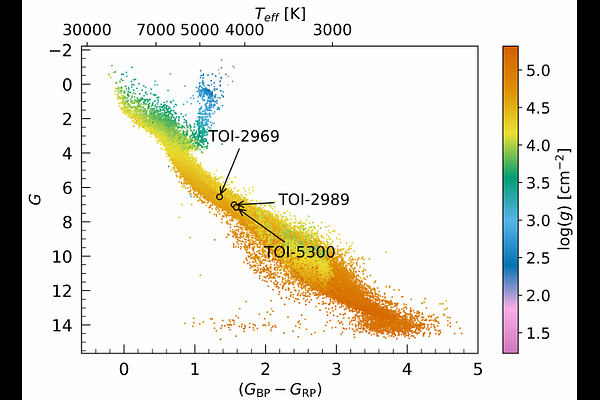Three Hot Jupiters transiting K-dwarfs with a significant heavy element mass

Three Hot Jupiters transiting K-dwarfs with a significant heavy element mass
Y. G. C. Frensch, F. Bouchy, G. Lo Curto, S. Ulmer-Moll, S. G. Sousa, N. C. Santos, K. G. Stassun, C. N. Watkins, H. Chakraborty, K. Barkaoui, M. Battley, W. Ceva, K. A. Collins, T. Daylan, P. Evans, J. P. Faria, C. Farret Jentink, E. Fontanet, E. Fridén, G. Furesz, M. Gillon, N. Grieves, C. Hellier, E. Jehin, J. M. Jenkins, L. K. W. Kwok, D. W. Latham, B. Lavie, N. Law, A. W. Mann, F. Murgas, E. Palle, L. Parc, F. Pepe, A. Popowicz, F. J. Pozuelos, D. J. Radford, H. M. Relles, A. Revol, G. Ricker, S. Seager, M. Shinde, M. Steiner, I. A. Strakhov, T. -G. Tan, S. Tavella, M. Timmermans, B. Tofflemire, S. Udry, R. Vanderspek, V. Vaulato, J. N. Winn, C. Ziegler
AbstractAlbeit at a lower frequency than around hotter stars, short-period gas giants around low-mass stars ($T_\mathrm{eff} < 4965$ K) do exist, despite predictions from planetary population synthesis models that such systems should be exceedingly rare. By combining data from TESS and ground-based follow-up observations, we seek to confirm and characterize giant planets transiting K dwarfs, particularly mid/late K dwarfs. Photometric data were obtained from the TESS mission, supplemented by ground-based imaging- and photometric observations, as well as high-resolution spectroscopic data from the CORALIE spectrograph. Radial velocity (RV) measurements were analyzed to confirm the presence of companions. We report the confirmation and characterization of three giants transiting mid-K dwarfs. Within the TOI-2969 system, a giant planet of $1.16\pm 0.04\,M_\mathrm{Jup}$ and a radius of $1.10 \pm 0.08\,R_\mathrm{Jup}$ revolves around its K3V host in 1.82 days. The system of TOI-2989 contains a $3.0 \pm 0.2\,M_\mathrm{Jup}$ giant with a radius of $1.12 \pm 0.05\,R_\mathrm{Jup}$, which orbits its K4V host in 3.12 days. The K4V TOI-5300 hosts a giant of $0.6 \pm 0.1\,M_\mathrm{Jup}$ with a radius of $0.88 \pm 0.08\,R_\mathrm{Jup}$ and an orbital period of 2.3 days. The equilibrium temperatures of the companions range from 1001 to 1186 K, classifying them as Hot Jupiters. However, they do not present radius inflation. The estimated heavy element masses in their interior, inferred from the mass, radius, and evolutionary models, are $90 \pm 30\,M_\oplus$, $114 \pm 30\,M_\oplus$, and $84 \pm 21\,M_\oplus$, respectively. The heavy element masses are significantly higher than most reported heavy elements for K-dwarf Hot Jupiters. These mass characterizations contribute to the poorly explored population of massive companions around low-mass stars.